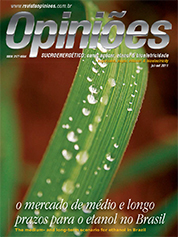Manoel Carlos de Azevedo Ortolan
President of Canaoeste
Op-AA-29
Planning to take advantage of the opportunities
To avoid a prolonged shortage of sugarcane that might severely upset the sugar-based energy industry, it is necessary to immediately increase investments in the renovation and expansion of sugarcane plantations and in industry. The demand for ethanol will increase in the domestic market, mainly due to the accelerated growth of the flex-fuel vehicle fleet.
However, other applications of ethanol, such as sugarcane diesel, the chemical and bio-plastics industries, for example, will also require production increases. This is a challenge the sugarcane chain will have to face.
This same challenge, however, can also be viewed as an incentive for the expansion of investments in products that aggregate more value to sugarcane. To implement innovations and to maximize current technologies are challenges that require partnerships and cooperation among all links in the sugarcane agribusiness.
Certainly research in the development of new technologies, such as that of second generation ethanol, will gain momentum and considerably contribute to the verticalization of production gains, increasing the productivity of ethanol from sugarcane, but it will not suffice to meet the demand in the medium- to long-term.
Participants in the industry are often asked about factors that resulted in the recent increase in prices of products and also about the lack of sugarcane to meet industrial demand. The answer encompasses a series of events.
Between 2005 and 2009, the Brazilian sugarcane-based energy industry, on average, set up more than 20 new industrial units per year. At the time, the industry focused on the domestic market, but also on the growth of sugar and ethanol exports.
An investment boom in new industrial units took place. With the worldwide economic crisis, which began at the end of 2008, investments became rare due to the lack of credit and stringent financing conditions.
Climate factors also impacted recent harvests, as follows: 2009/2010 was an excessively rainy period that adversely impacted raw material harvesting operations and the production of sugar and ethanol. 2010/2011 was characterized by an intensive and prolonged drought that affected sugarcane plantations.
In the current 2011/2012 harvest, one noticed a series of restrictions for vegetative development, again caused by climate phenomena, which chronologically occurred as follows:
a. in the beginning of March, in an expressive sugarcane plantation area in the Center-Southern region, a strong floral induction occurred that inhibited the growth of culms on new inter-nodes, a reduction that may have represented losses of sugarcane and sugar tonnage in an amount corresponding to that of the entire month of March;
b. frost occurred in the states of MS, PR, and in considerable parts of SP, followed by intensive rainfall (except in the region of Araçatuba-SP), which resulted in the deterioration of the affected culms. One should also point out that in the current harvest the strong drought that is already occurring may last until the beginning of September.
The recovery of sugarcane production should have started in the beginning of 2011. However, rainfall up to the end of April and its sudden interruption the following month compromised the planting in terms of quality and area, postponing the recovery of sugarcane plantations.
The sugarcane planted in May and June will certainly yield less than if it had been planted from February to May, the most adequate planting period. The sugarcane plantations of the Center-Southern region in the current harvest could be producing in excess of 600 million tons.
New projections, however, indicate a production of 530 million tons of sugarcane. In addition, one can notice the reduction in raw material quality, in the comparison with the previous harvest. This reduction is highly significant and needs to be very well managed to avoid heavy losses for the sugarcane-based energy industry.
Recently, the Americans signaled that they would do away with internal subsidies and import tariffs, making our ethanol more competitive. This is an important gesture that goes in the direction of what the Brazilian industry has always expected. Now is the time to open “doors” to opportunities, uniting forces to plan the industry’s development, preparing it for the challenges of the future, all of which are well known.
The expansion in terms of new mills and sugarcane plantations will essentially depend on public policies oriented towards investments. It is urgent that funds be made available so that new industrial units can materialize. One should always recall that a mill to come on stream, on average, requires four years, from its construction to the start-up of operations.
In other words, it is likely that the production recovery of the industry will only occur in the medium- to long-term. Furthermore, attention should also be paid to sugarcane producers, notably the small- and medium-size ones that concentrate an expressive share of the country’s production and rely on incentive policies.
The producer is always the first link in the chain to suffer the economic impacts and is also the weakest, which does not make him the less important one. Quite to the contrary, without raw material the subsequent links of the production chain do not exist.
Estimates show that in the 2015/2016 harvest Brazil will have to produce 1 billion tons of sugarcane to meet production needs. This means additional 400 million tons. This scenario would require around 135 new units, with annual crushing capacities of 3 million tons each.
The outlook is quite good, but we cannot forgo the opportunity. The sugarcane-based energy industry and the government must act quickly to meet the common objectives, but more importantly, those of the country. What it takes is planning and a lot of discipline, least we stand by watching the opportunity go by.




